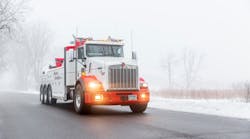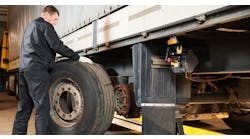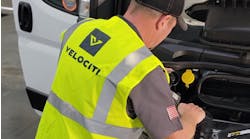Downtime is the antithesis of productivity for a fleet operation. When that downtime is unexpected, or becomes an emergency situation, it is even more integral to have a plan in place to efficiently and effectively respond to issues, so the problem does not get exponentially worse.
When an emergency roadside situation occurs, a safe and organized response is crucial. Adhering to these critical steps can minimize not only the loss or damage of cargo but also protect and potentially save the lives of the driver and others on the road who may be in jeopardy.
Having a plan in place to handle the before, during, and after of an unexpected tractor tow or vehicle recovery can help fleets to better plan for these events.
Prep when possible
In preparation for the unexpected, fleets should first vet and select one or several towing and recovery service providers that best suits their needs. When selecting a service provider, review the network they serve. There may be instances where a fleet runs outside of the network, or a fleet may require a nationwide network to provide service.
Once a service provider is selected, the fleet should apply to be added to the towing and recovery company’s account base. Information such as the main fleet contact, purchasing agent, accounts payable staff, and fleet manager should all be provided to the tow company, says Randy Resch, tow operator expert and owner of Randall Resch Training.
Additionally, consider if the towing provider also offers their own mobile maintenance services. There are benefits and drawbacks to this.
A service provider offering both mobile maintenance and towing/recovery service can expedite the process to make it more seamless and better communicate between the two departments. Blaine Brothers offers this type of service.
“Our guys do work together quite well and know what our capabilities are together,” says Mike Lamphier, towing service advisor for Blaine Brothers. “If you are working with another service provider, it's just a little bit more work to make sure that you're coordinating your efforts. We certainly like to have our own guys working together out there [whenever possible].”
Blaine Brothers operates 10 facilities throughout the Midwest to provide 24/7 towing and recovery services, on-site and mobile maintenance and repair service, and parts sales.
“The benefits are a reduced number of service provider relationships required in serviced markets and the ability to shift from a roadside breakdown to a tow without having to contact another provider,” advises Jeffrey Godwin, vice president, software solutions for FleetNet America. FleetNet America provides vehicle repair and emergency road services throughout North America.
One consideration is that a full-service provider offering both maintenance and towing may be better suited or trained in one over the other.
“Those towing companies who dip their toe … in the pool and add a service vehicle may not have adequate inventories or highly trained mechanics who might prefer to work in a more mechanically intensive environment,” Godwin suggests. “For mobile mechanical providers who simply add a tow truck, they are generally also the operator of the repair shop. This can be good, but the towing operator may be more of a mechanic tasked with towing rather than a trained professional tow operator.”
Brian Riker suggests dedicated mobile maintenance providers may specialize in certain vehicles or systems, while dedicated towing service providers who also provide some mobile maintenance services may likely offer more general services. Riker is president and chief compliance specialist for Fleet Compliance Solutions, a transportation compliance consulting company for the commercial vehicle market.
Additionally, “they may be more inclined to tow the breakdown into their shop rather than repair it roadside,” Riker advises.
He adds that service providers will also take into consideration how quickly their tower can get off the side of the road.
“On average, a tower or mobile mechanic is struck by a passing vehicle once every six days in the U.S.,” he says.
“For those [fleets] who do not use a full-service solution such as FleetNet America, having a network of service providers and a relationship with those providers who serve the areas where you operate is very important,” Godwin says. “Whether this is simply an account with established rates or a closer relationship likely varies depending on the size of your operating area.”
During the event
Steps taken during an emergency service event can vary. It may be the vehicle is disabled on the roadside requiring a mobile maintenance call and quick service.
As soon as the truck is disabled on the side of the road, so long as there is no imminent danger to the driver or other passengers, the driver should be sure to gather and place the appropriate safety equipment to alert other motorists. Safety is imperative – for the driver, the tow or recovery expert, and any other individuals who may be on-hand during the response call.
In much more challenging circumstances, the vehicle could be blocking traffic, leaking hazardous fluids, or have been part of an accident. In this instance, a tow or vehicle recovery may be necessary.
A tow or recovery contractor responding to a service call requires as much information as possible to ensure a safe and quick response. This means clear and concise communication between the driver and the fleet should already be established, with a standard process in place including a point of contact for the fleet to coordinate with the service provider.
“Knowing the exact nature of the service request helps improve response time and ensures the correct information is brought out the first time,” Riker advises. “Making available copies of the bill of lading or load manifest, especially if hazardous materials are present, will give the tower or clean-up contractor a guide to the potential material handling needs as well as the urgency for protection of the environment.”
“The fleet’s company dispatch should already have on-hand the information of the disabled, stuck, or wrecked truck to be passed onto the tow company’s dispatcher,” Resch says.
He suggests providing the exact location of the vehicle including landmarks, mile-post markers on the highway, and load dimensions, if they’re available. The towing company will also need the driver’s phone number to reach them on-site. A backup contact number is helpful in the event the driver does not answer.
“Ensure accurate location information can be gathered from your fleet when a breakdown occurs along the roadway,” FleetNet’s Godwin says. “This can be done with a telematics system, or simply by training your drivers on how to get their location information from their phones.”
The driver or fleet should be able to also provide the year, make, and model of the vehicle as well as the engine type and transmission type, Riker says.
“Advising the responding contractor of the condition of the vehicle and load, with pictures if available, will allow them to be best prepared for what they will find on scene,” he adds. “The way a tower approaches a recovery, cleanup, or even a routine breakdown tow varies based on the vehicle type, load, condition of the vehicle, and location.”
Resch agrees photos from the scene can expedite the process of towing or recovery. He suggests the driver or any other person on-location use a smartphone to take a photo or two of the vehicle to send back to the towing company. This can provide additional details on the requirements of the recovery or tow.
“Training the fleet driver to take pictures and having an easy method to transfer them to the company official in charge of managing the response also helps prepare the responders for what they will face long before they arrive on scene,” Riker says. “These photos also help prepare an accurate picture for the insurance claims adjuster.”
Providing all of this information before the towing or recovery contractor heads to the location expedites the process.
“Certain situations call for different equipment,” Blaine Brothers’ Lamphier says. “It'd be good to know that ahead of time before arriving on-site, versus getting onsite and waiting for more equipment to show up.”
Law enforcement involvement
When law enforcement responds to an accident or a disabled vehicle blocking traffic, the fleet may no longer have a say in the towing or recovery service provider. Depending on the location of the incident, law enforcement may have a single provider for their jurisdiction or will rotate through a list of set providers. Service rates are set between that provider and the law enforcement agency.
“Even if the trucking company is a long-haul truck line, most have support services they use on a call-out basis,” Resch says. “There’s nothing to say that the semi-truck’s driver can’t discuss the tow or recovery with the officer who’s on-scene. If a requested tow company is local and quick response can happen, the officer may allow the semi’s driver to call their own provider.”
“Often the owner’s requested provider must be able to respond within a reasonable amount of time, typically 30 to 60 minutes, depending on the situation,” Riker adds. “If the driver is not incapacitated, they should always ask the officer if they can call the provider of their choice as soon as it becomes apparent a tow is required.”
“When public safety becomes the issue, law enforcement generally will take the lead,” Resch says. “Any officer may make an estimated determination of danger and road blockage based on their experience and on-scene factors.”
Examples of these factors may be a broken or damaged trailer, hazardous leaks, or an active fire.
Additionally, if the law enforcement officer believes the crash may have been due to a driver’s poor decision or issues with the equipment, special towing services may be called.
“The scene may be deemed an evidence investigation where a designated ‘evidence tow contractor’ will be called to handle the recovery, removal, and ultimate storage,” Resch says. “In any scenario where evidence is considered, the trucking company has no say as to who can recover or tow their vehicle and trailer.”
In the event a fleet does not have the option to work with their selected contracted towing service provider, Riker recommends sending someone else from the fleet out to the scene as soon as feasible to monitor the situation.
“When dealing with a non-consent situation, the fleet should try to get their own representative on-scene as soon as possible,” Riker says. “This can be either a local company manager, representative from their insurance company, or even a third-party claims management company. This person will act on behalf of the fleet to take pictures, authorize recovery/cleanup plans, and make arrangements to secure and protect the salvage value of the equipment and cargo.”
“In cases where law enforcement calls a service provider, unless the fleet has a preferred provider who may be able to assist in the situation, it is best to begin contact with the service provider [call on by law enforcement] as early as possible to be a part of the process,” FleetNet America’s Godwin says.
It will not always be possible to work with a known service provider. Riker advises to confirm as much information ahead of the service, if at all possible, such as certifications, licensing, and permits. Additionally, confirm payment options up front. This includes storage and disposal fees.
Riker suggests another question to verify as well: “How much of the job [will they] be handling in-house versus sub-contracting? This can drastically affect the price for service if a tower must sub out a large portion of the job it may be more economically feasible to hire a different contractor, if the time and situation allows.”
Ahead of the service, Riker also says to verify where the truck, trailer, and cargo will go after tow or recovery.
“If at all possible, the fleet should make arrangements to have the vehicle delivered to their own facility and pay the charges due upon delivery,” he says. “This allows the fleet manager to maintain control over the salvage value of the cargo – if it’s a wreck or spill clean-up – or quickly assess and return [the vehicle] to service.”
In the event the driver is the only fleet representative present, Riker says drivers can help on the fleet’s behalf.
“Have them take as many pictures as possible, but remind them not to say or sign anything,” Riker says. “Things to document include the different pieces of equipment the responders brought to the scene, how it was used, the extent of the wreck or spill, and the time on scene from start to finish.”
Recovery options
“Recovery is not exact science,” Resch explains. “The process of winching, lifting, and in-line rolling may inflict further ground-gouging or cause leaks from the casualty beyond the [towing] operator’s control. The property owner should be made aware of that possibility where the tow company is not held responsible for damages beyond [the service provider’s] control. In some cases, the tow company may be certified in ‘return to normal’ site restoration which may be billed as a separate fee of its own.”
If the service call requires vehicle recovery, providing a short verbal or typed reasoning as to how the vehicle ended up in the situation can better assist the service provider, suggests Resch.
He offers the following detailed examples: “The driver was backing out and went rear wheels into a ditch and is high-centered on a rock,” or “The truck was dumping its load of sand and tipped over onto its driver’s side.”
“A visual evaluation of on-site hazards is necessary, especially those surfaces where heavy wreckers must drive,” Resch adds.
When providing details, fleets should note obstacles such as difficult-to-access driveways or roadways, fire hydrants, exposed pipes or culverts, etc. Also note power lines are a hazard for heavy wreckage recovery vehicles, particularly those which require the use of raised booms.
“High-voltage energy is capable of arcing as far as 10 to 20 feet onto metal sources where electrocution is possible,” Resch advises. “When working near overhead power lines, a spotter is required.”
When the tow or recovery truck arrives, the driver of the disabled vehicle should provide the vehicle’s keys to the tow operator. In general, the driver should not assist with the towing hook-up process but still provide input and answer questions regarding what happened to the vehicle and the load details including items hauled and estimated weight of freight.
“The preferred location for the semi driver is to be seated in the tow truck with their seatbelt on,” Resch says. “Keep in mind that the attachment process can take upwards of 30 minutes. If not seated in the [tow] truck, another place of safety might be forward of the tow truck’s location or, on the backside of the guardrail, or up an embankment if safe to do so. Stay away from the traffic side of [the scene].”
The cleanup process
For recovery requiring additional cleanup services, the process can become even more extensive. Some towing and recovery operations have certifications necessary to handle this. Otherwise, an additional service provider that specializes in environmental cleanup may be required.
“Full-service tow and recovery companies are required to be licensed, permitted, and experienced in capturing, retaining, removing, and transporting hazardous materials,” Resch says. “They work in dangerous, harsh environments that demand calculated safety and precision necessary to not allow or cause run-off, down-stream pollutants, additional damage, or create further risk to the public.”
This certification is known as Hazardous Waste Operations and Emergency Response Standard, or HAZWOPER.
“Services at this level are billable,” Resch advises.
Additionally, this cleanup will be included on the itemized bill. Photo or video capturing capabilities may be employed to accompany the bill. It is important to note that a thorough cleaning is integral to the safety of the motoring public to avoid any secondary accidents from occurring, such as remnant or leftover fluids or debris which could cause follow-up crashes by other vehicles once the originating accident is cleared.
“Fleet managers oftentimes contradict the fact that the recovery scene requires extensive clean-up caused by a single incident,” Resch says. “And, when they are not on-scene to see the extent of what cleanup requires, [fleets] easily refute the tow company’s invoice. When a fleet’s truck is involved in a hazmat scenario, it’s recommended that the fleet manager responds to the scene to personally see what is entailed in working the scene.”
Insurance considerations
“It’s recommended that you contact your [insurance] agent beforehand to see what is and is not covered by your policy,” Resch advises.
Once an incident does occur, the fleet must work with the tow service provider and the insurance company to alert both parties of the accident.
Resch suggests providing an insurance claim number and the insurance agent’s contact information to the towing or recovery service provider. The fleet should also have the insurance provider send an estimator to the tow facility to assess damage and make arrangements to have the vehicle or debris removed from storage.
“It’s important the fleet manager notifies their insurance provider as to the incident and soon-to-come tow bill so to speedily get the claim process started,” Resch adds. “Doing so will help to lessen daily storage rates from climbing.”
“When dealing with a totally destroyed semi-truck or trailer, don’t let the insurance company walk away if they have responsibility to the insured’s property,” Resch says. “It’s been my practice to send the invoice to both the trucking company and the insurance provider. Keeping a level of pressure on the insured oftentimes helps in the negotiations or settlement of an invoice.”
Insurance coverage can vary widely depending on the response needed for the disabled vehicle. Riker says towing and recovery riders are available through most commercial vehicle insurance providers.
“Most of the accident response and cleanup is covered by the public liability or cargo portion of a fleet’s insurance policy,” Riker adds. “My best recommendation is to make sure their cargo policy will cover cleanup under the conditions they operate their fleet.”
He says some examples may include all company equipment, owner operator or contractor, and trailer interchange.
Understanding the invoicing
Towers and recovery companies have a responsibility to provide an itemized bill with clear and thorough descriptions of services rendered. Fleets should approach a dispute with courtesy and ask questions to get explanation or clarification on any unclear information.
“A well-written tow invoice will have all regulated fees detailed to explain the work, time on-scene, portal-to-portal travel time, personnel and trucks on-scene, and all costs of that work,” Resch says. “A well-presented tow invoice should include photographs, ground-based video, or overhead drone coverage of the recovery.”
Towing and recovery service providers cannot provide an estimate for a job ahead of time, due to the many variables for any response situation. However, a fleet can confirm the hourly rates and fees for some services such as lifting, up-righting, mobile service, tire changes, heavy winching, off-decking, etc.
“One thing that we pride ourselves on is that we hope to be able to communicate all of the reasons for the cost to the customer, whether it's pictures, a good detailed write-up of what was going on and offloading time or applications with the job, make sure that we keep track of all that so that we can relay the information to the customer to justify the bill,” says Dean Dally, president and CEO of Blaine Brothers.
When questions arise or the fleet wishes to dispute a charge, they should remain calm and talk through any concerns.
“Stay calm and be reasonable while the investigation is being made,” Dally says. “We will get calls at times where the first thing you hear is somebody very angry and quite vocal. It's not nearly as productive of a discussion when the person is taking that stand.”
“It is certainly within a fleet’s rights to request an itemized invoice and that should be expected,” FleetNet America’s Godwin says.
Another option may be to get another opinion from a trusted source, Riker suggests.
“If this is a company that you do not normally deal with, such as a non-consent tow or recovery, ask one of your trusted service providers to give the invoice a review,” he says. “They can often help you understand what the other company did, why they did it, and if it was justified.”
Note the itemized invoice may include separate billing for the tractor and the trailer load.
When following up on a tow or recovery, ask for the invoice soon after the event. This can help to expedite the process and ensure both parties conduct a respectful transaction.
“If you pay a tow bill immediately and their service was reasonable, timely, and with minimum loss and additional damage, the tow company will appreciate your timely payment and be most willing to help you in the future,” said Resch.
“It is in the fleet’s best interest to secure the quick release of the vehicle and cargo, especially if the vehicle is repairable or the cargo is perishable,” Riker adds. “Preserving salvage value will help control the total negative effects of the loss.”
Once the full service is completed and the bill is settled, fleets would do well to review the process and ensure the response was as expected, Riker suggests. He advises to keep records of both the good and bad service providers, and to make adjustments to the response plan if needed.
“Document everything,” Riker says. “Telematic records, dash cam[era] footage from responding [law enforcement] agencies, and other resources can help paint a better picture of what happened, why, and when so as to educate the fleet managers how to better respond.”
“Every situation is different and reviewing the event after the fact may allow insight into preventive maintenance that may have avoided the cause,” Godwin says. “The key is to not only review the problem and the solution, but to identify what led to the issue and to mitigate where possible.”




